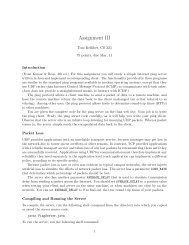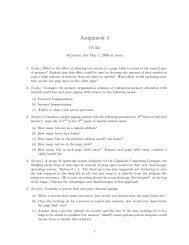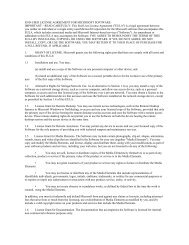Flesh and Machines - Phoenix Goucher
Flesh and Machines - Phoenix Goucher
Flesh and Machines - Phoenix Goucher
You also want an ePaper? Increase the reach of your titles
YUMPU automatically turns print PDFs into web optimized ePapers that Google loves.
all electric motors, but the inclusion of springs <strong>and</strong> advanced control mechanisms have lead to very humanlike<br />
motions. Humanoid robot arms equipped this way are able to achieve subtle mo tions in response to external forces.<br />
While still clumsy by human st<strong>and</strong>ards they are starting to make progress toward the sorts of interaction with objects<br />
that a four-or-five-year-old can do routinely. This is very different from the actions that we have associated with<br />
robots from seeing industrial robots pick up <strong>and</strong> place objects from precise locations <strong>and</strong> with incredible speed.<br />
The source of energy for our humanoid robots is electricity from a wall socket. There is no imperative for them to<br />
gather, store, steward, or expend energy sparingly. At this point in time they do not need to engage in so many of the<br />
behaviors that we humans engage in, almost unconsciously, every day, to maintain our bodies <strong>and</strong> our existence. We<br />
must eat <strong>and</strong> drink every few hours to survive. We must sleep on a daily basis to remain healthy. We must breathe<br />
every few seconds or we die in a matter of minutes. As long as our humanoid robots are freely plugged into a wall<br />
socket, they have no need to do any of these things. There are a few early experiments that involve having robots<br />
gain their energy from digesting biological matter <strong>and</strong> using the resulting gases to run fuel cells. But as long as our<br />
robots are still primarily steel <strong>and</strong> silicon creations, that form of energy will be a novelty It will always be possible<br />
to tap into an electricity source directly <strong>and</strong> bypass the physiological imperatives.<br />
Sleep, however, is a different matter. The "reason" for sleep is still somewhat of a mystery. However, more <strong>and</strong><br />
more recent studies show that at least part of the picture is that it is a time when short-term memories gathered<br />
during the waking period are consolidated into longer-term memory. It may turn out that there are legitimate reasons<br />
why our intelligent robots will have to shut down some of their interactive abilities in order to make such orderly<br />
compressions of recent experiences. If that is the case, then sleep may become something necessary to our<br />
humanoids in order for them to learn <strong>and</strong> adapt. On the other h<strong>and</strong>, it is plausible that we as engineers may be able to<br />
come up with something cleverer than evolution was able to do, <strong>and</strong> to generate algorithms that can do this<br />
consolidation while the robot is fully functional.<br />
In the near term, the next ten to twenty years, say, it is a safe bet that our robots will remain very foreign in their<br />
physiology. It is likely that we will be able to make them more <strong>and</strong> more like humans in their external appearance.<br />
But we will always know that underneath their familiar exterior there is something very different from us.<br />
So much for physiology. What about emotions? Are the emotions of robots at all like those of humans?<br />
A number of robots that people have built, including Kismet <strong>and</strong> My Real Baby, are able to express emotions in<br />
humanlike ways. They use facial expressions, body posture, <strong>and</strong> prosody in their voices to express state of their<br />
internal emotions. Their internal emotions are a complex interplay of many subsystems. Some have drives, such as<br />
Kismet's loneliness drive, that can be satiated only by particular experiences in the world, in this case detecting a<br />
human face. Some have particular digital variables within some of their many concurrent programs with explicit<br />
names like arousal. There are many interactions between the emotional systems, the perceptual systems, <strong>and</strong> the<br />
motor systems.<br />
For instance, in Kismet, when the loneliness level is high, the visual system rates things that have skin color as more<br />
interesting than the saturated colors of toys. As a result, there will be a higher tendency for Kismet to saccade<br />
toward things with skin color, which in its laboratory environment means that it will probably saccade to a human<br />
face if one present. Human h<strong>and</strong>s are the other skin-colored objects in its environment, but they are usually smaller<br />
<strong>and</strong> thus less attractive than faces. If the loneliness level rises, it will tend to shift Kismet's emotional state away<br />
from happiness. Kismet will more likely become fearful or angry in response to small annoyances from moving<br />
objects near its face. It will display those emotions through its facial expressions <strong>and</strong> vocalizations. As it gets<br />
unhappier <strong>and</strong> unhappier, lonelier <strong>and</strong> lonelier, it will refuse to look at a toy even if that is the only thing in view.<br />
This is similar to what happens in the human brain, where there are primitive centers of emotion such as the<br />
amygdala <strong>and</strong> other parts of the limbic system. These structures receive inputs from many parts of the brain's<br />
perceptual subsystems, <strong>and</strong> at the same time innervate both primitive motor sections of the brain <strong>and</strong> the more<br />
modern decision-making <strong>and</strong> reasoning centers of the brain. Antonio Damasio, a neuro-scientist in Iowa, has<br />
explained the role of these structures in popular books about the relationship between emotions <strong>and</strong> more advanced<br />
centers in the brain. His message, in brief, is that emotions are both primitive in the sense that we carry around the<br />
emotional systems that evolution installed in our brains long before we had warm blood, <strong>and</strong><br />
that they play intimate roles in all of the higher-level decisions that we tend to think of as rational <strong>and</strong> emotionless.<br />
So our robots are being built with emotional systems that model aspects of what goes on inside the heads (<strong>and</strong><br />
hearts) of humans. But is "model" the operative word here? Are they real emotions, or are they only simulated










